Depictions of Queer Black Love for the Digital Age
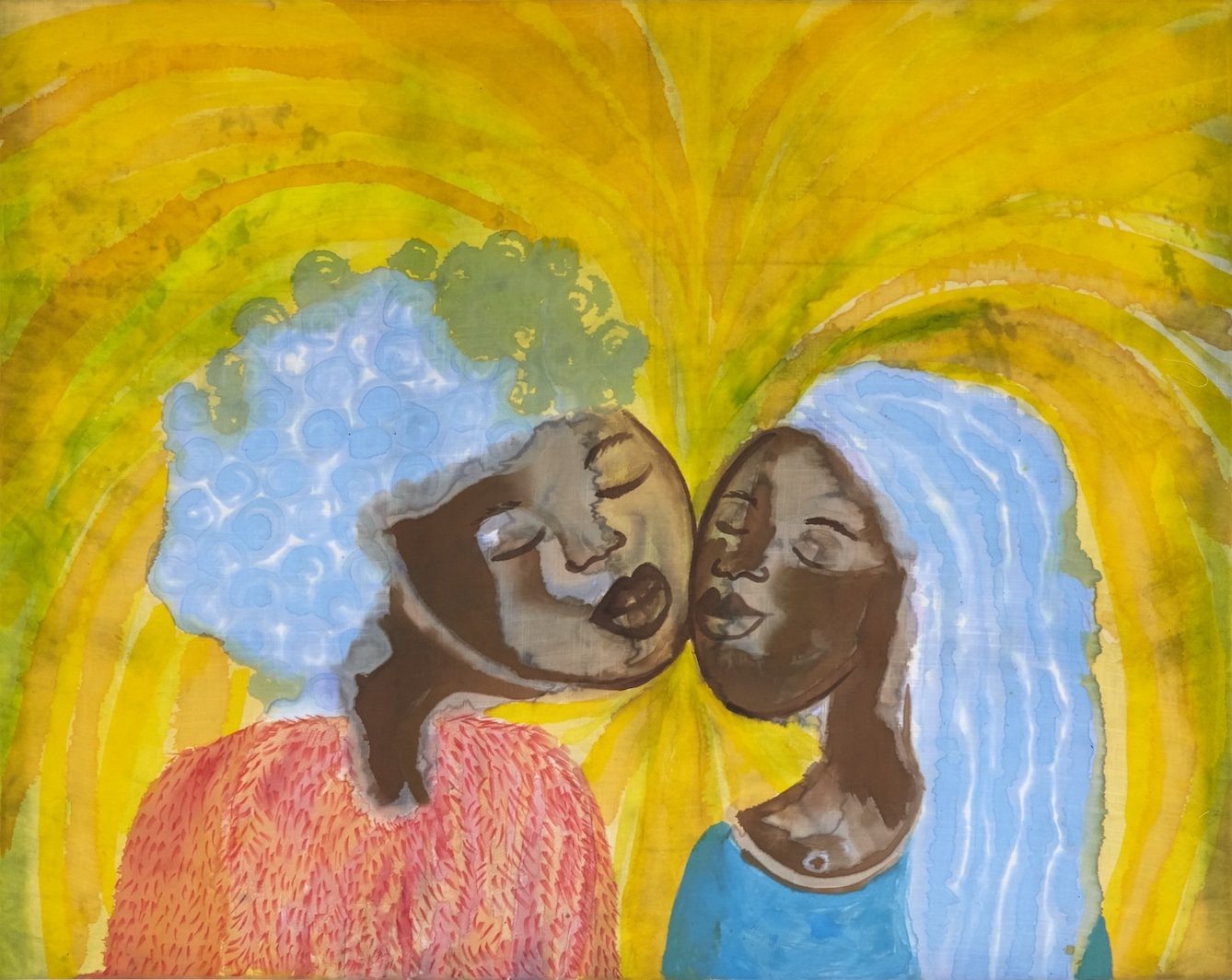
01 April 2020
Magazine C& Magazine
Words Olamiju Fajemisin
7 min read
A new generation of young painters in Europe are using internet languages to create multilayered aesthetics and narratives. Revising traditional techniques with a digital sensibility, these artists are opening themselves and the medium up to previously unconsidered possibilities. In this series, Digital Strokes, we highlight some of these young artists. First up is Sola Olulode, who combines wax, ink, bleach, textiles and paint in an exploration of Yoruba techniques to create works featuring queer love, writes Olamiju Fajemisin.
Sola Olulode’s painted world is entirely her own. Curated by Zina Vieille and Nnamdi Obiekwe at V.O Curations, London, Where the Ocean Meets the Beach is an exhibition saturated with loving movement – of both Olulode’s hand and brush, and of the figures she renders in brilliant blues, honeyed yellows, and rich browns. Imbued with heady romance, almost all of the twelve paintings on show were created during Olulode’s residency at V.O Curations, of which the end is marked by this exhibition. Perhaps Olulode is a diarist as well as a painter. Through the lens of social interaction, she charts narratives of queer Black love as they emerge before her – as they emerge before us all. Her lively assemblages of wax, ink, bleach, paint, thread, and canvas exist as portals through which we can witness an ideal true love. While arguably more conceptual practices dominate among her peers, the Brixton-born artist captures fleeting QTIBPOC (Queer, Trans, Intersex, Black People, and People of Colour) romance as a contemporary feeling, archiving it and celebrating it.
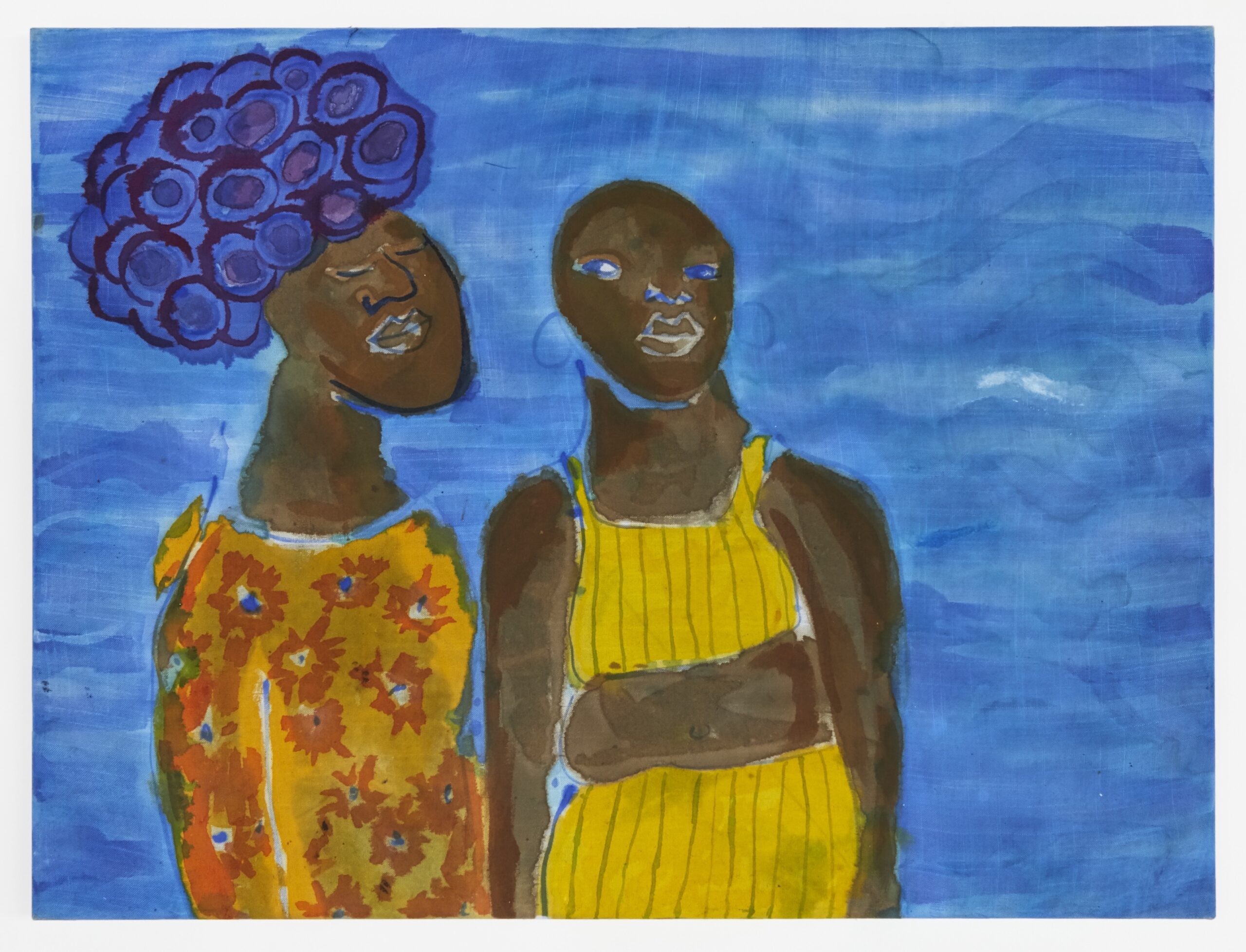
Sola Olulode, Waves, 2020.
“When titling my paintings, as I’m not great with words, I turn to other people’s. To their lyrics and poetry. I’m interested in the ocean and the way it moves,” Olulode says, “how expansive it is. There are ups and downs. It’s incomprehensible and deeply mysterious.” Taken from Travis Alabanza’s poem “The Sea,” the exhibition’s title refers to a futile attempt to describe the indescribable. Alabanza begins: “Sometimes I stand by the edge of where the ocean meets the beach, and look out into the sea, so I can see something that does not have an end.” Alabanza writes on the genderfluid experience as a “boundless place,” on its nuances and malleability. Olulode appropriates this sentiment, suspending her figures in a place unknown to us. They are neither indoors or outdoors; it would be a struggle to date them by their clothing. At times, the lines demarcating limbs from body from hair from backgrounds vanish entirely. Some of the Black bodies aren’t Black at all, but indigo or turmeric-yellow, their features etched in bleach or emphasised with wax. Suddenly the familiar painted format seems unfamiliar. Who are they? Where are they? “They exist in a space that is purely emotion,” I’m told. “These people are in love, with each other. It’s not friendship, though some people assume that.”
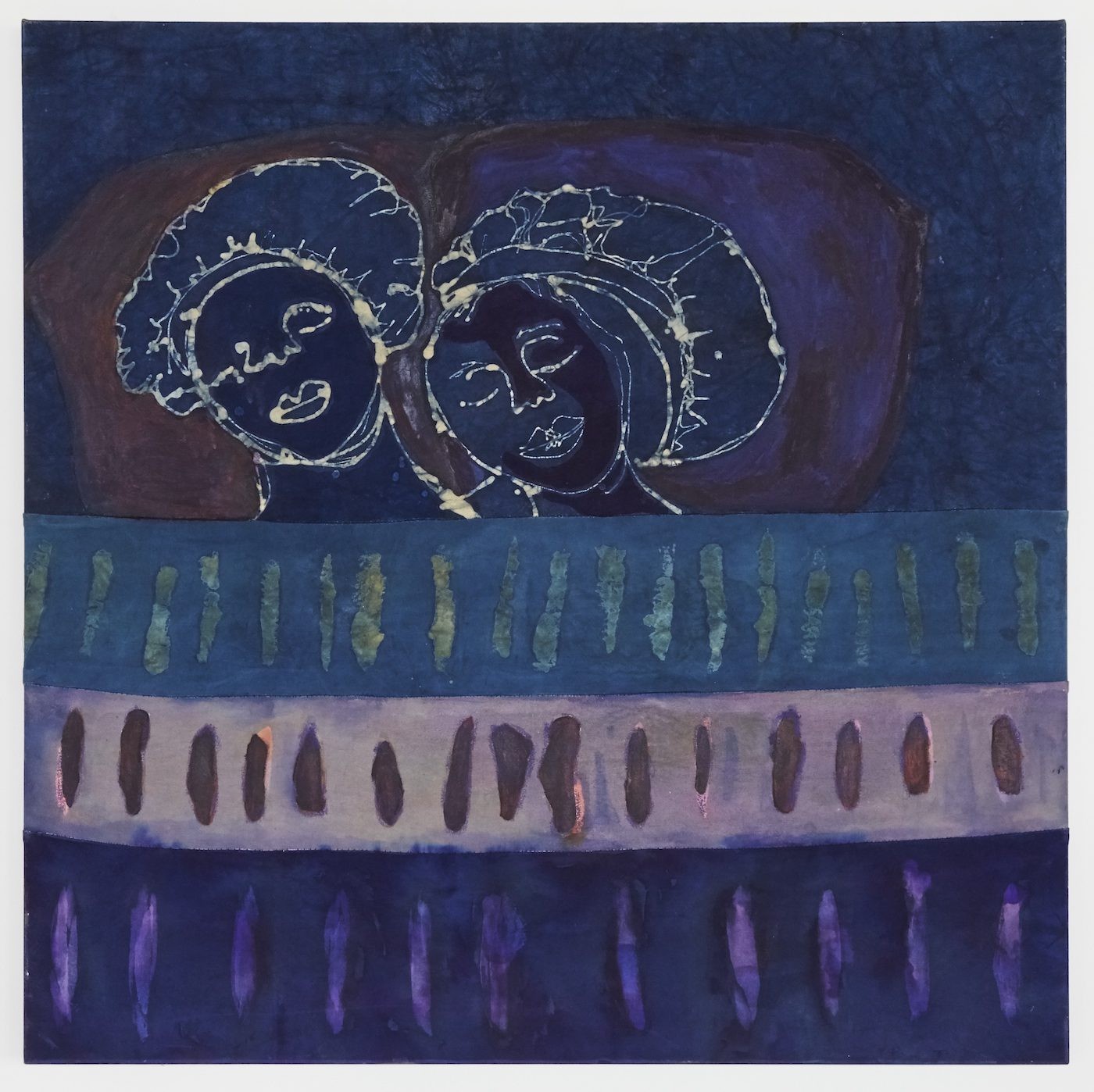
Sola Olulode, Safety, 2019.
Working from screenshots of viral videos, images of doting queer couples, and other resources found on the internet, Olulode paints Black queer romance in a world beyond reality, a place it can thrive unquestioned. She says: “When painting dancers I look for specific energetic moments to capture. I guess it’s quite intuitive for me.” Unlike Lubaina Himid’s life-sized and almost interactive cutouts, Olulode’s figures, unheeding because of the attention they give to one another, appear impervious to our gaze. If they look forward, they look past us. Or, as in Entwined (2019), only at one another. “I’m always looking at relationships. Relationships between women and non-binary people,” Olulode tells me. It’s all we’re supposed to look at too.
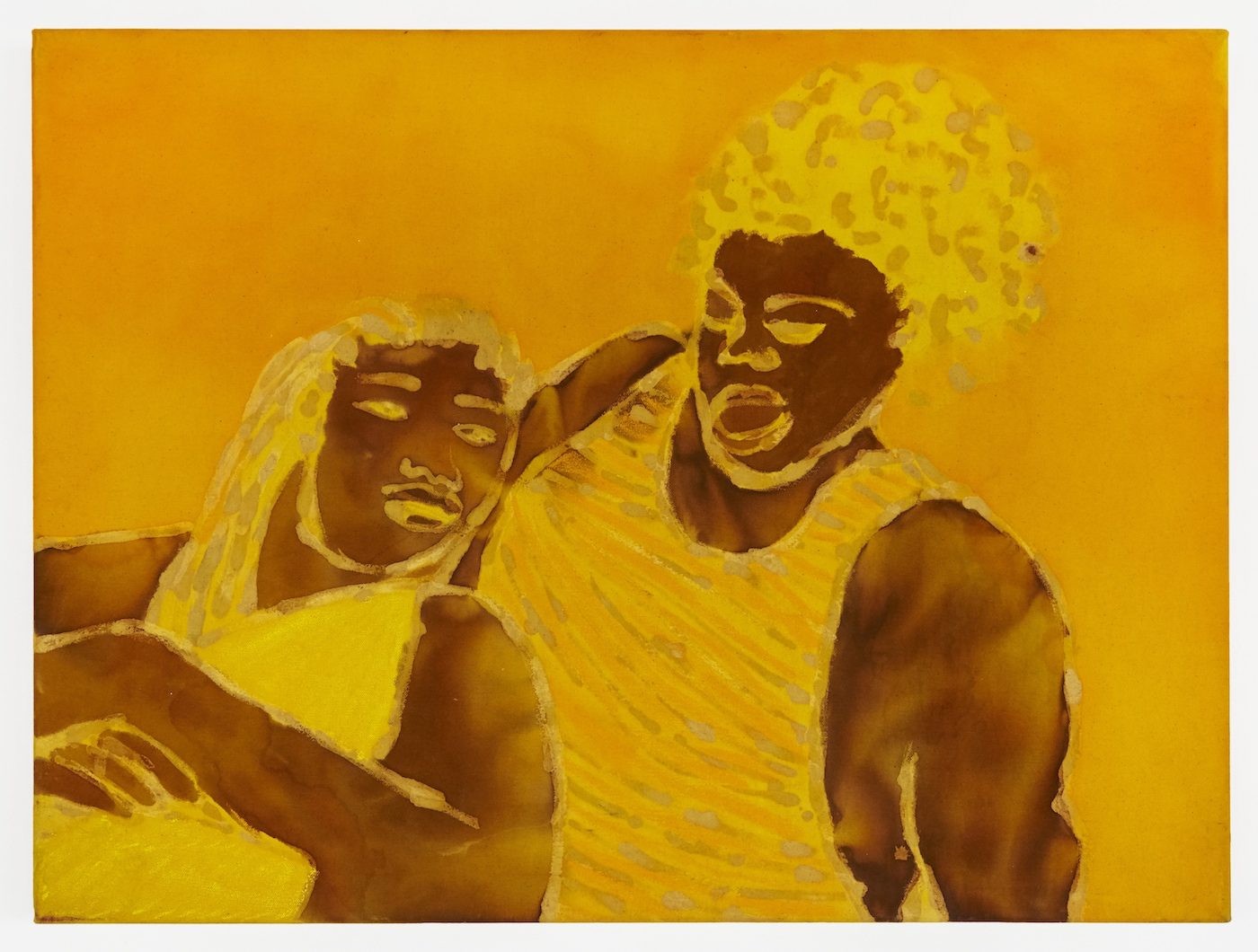
Sola Olulode, A Perfect Summer’s Day, 2019.
“Because the scenes I paint are often happy and joyful and idealistic, it can only be fantasy.” Olulode says, sat on the floor of her studio. We walk down the hall, into the exhibition space. I gaze at the paintings. Suddenly, my joy is usurped by melancholy. I am looking at a fantasy world. Layers of appliqued canvas, heavily impastoed pigment and dribbled wax further separate the world of her figures from our own. Their dances are motionless, isolated and silent. Their ecstasy contained by the parameters of their frames. Perhaps there’s also refreshment to be found in this fact. To read Olulode’s paintings is to become a voyeur. We do not enter into a dialogue with the figures, rather, they telltheir love to us. Their unclear temporal and spatial location only exasperates the sense that one is gazing through a window, or a portal. “They exist in a space that is purely emotion,” Sola tells me. “I want the viewer to be able to connect, to look at these joyful depictions and allow it to warm them.”
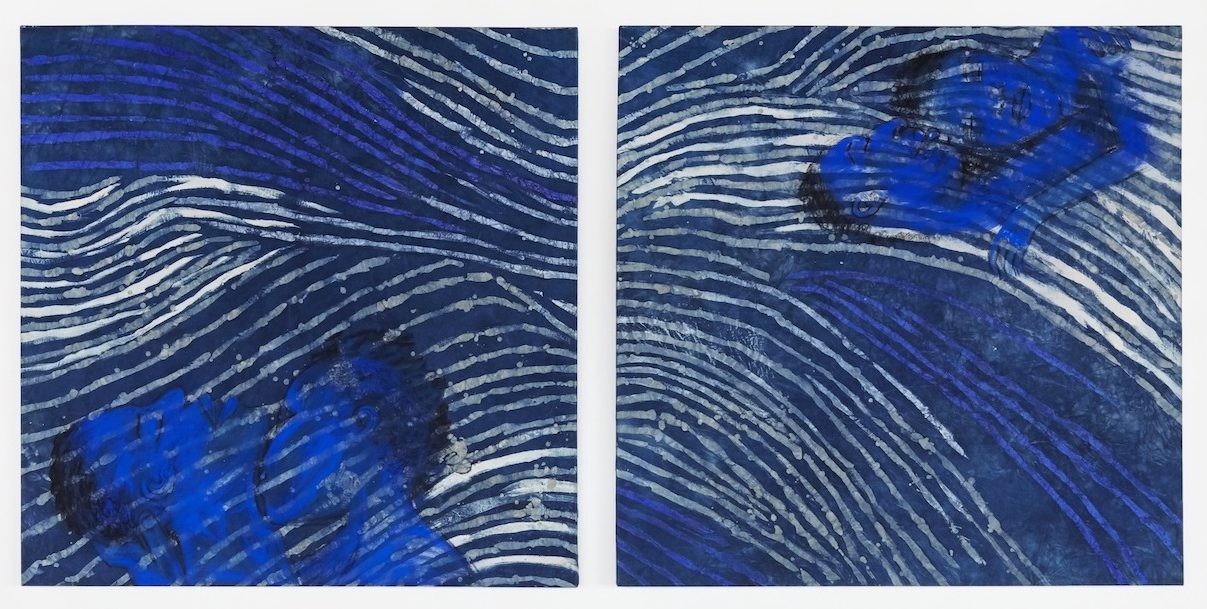
Sola Olulode, Loving You is Like Living on a Wave, 2019.
There is a playfulness in the way Sola Olulode recounts her creative processes. I ask, why painting? Why not film? “Listening to Denzil Forrester speak, looking at his work, seeing how he allows that energy to translate, how he captures it, is something I’ve tried to do too. I want to express the figure’s feelings through the marks and strokes of my brushes.” Just as Chris Ofili toyed with the limits of densely layered, multimedia painting through large-scale works such as No Woman, No Cry (1998), Olulode muddles the definition of painting, centralizing the use of wax, composite canvas, and other non-traditional techniques in her practice. “My education was very Eurocentric,” she says. As a final-year fine art student at the University of Brighton (from which she graduated in 2018, being shortlisted for the Evening Standard Art Prize that same year), Olulode wrote her dissertation on traditional Yoruba artists’ techniques, how they’re still being used and adapted by contemporary artists. “I guess I’m trying to do that too,” she continues, gesturing to the Ofili catalogue on the shelf above her. “The surface of the canvases form the foregrounds in my work. I’m not just painting on a flat surface, I’m mapping out the design and shape of the figures before I even apply paint.”
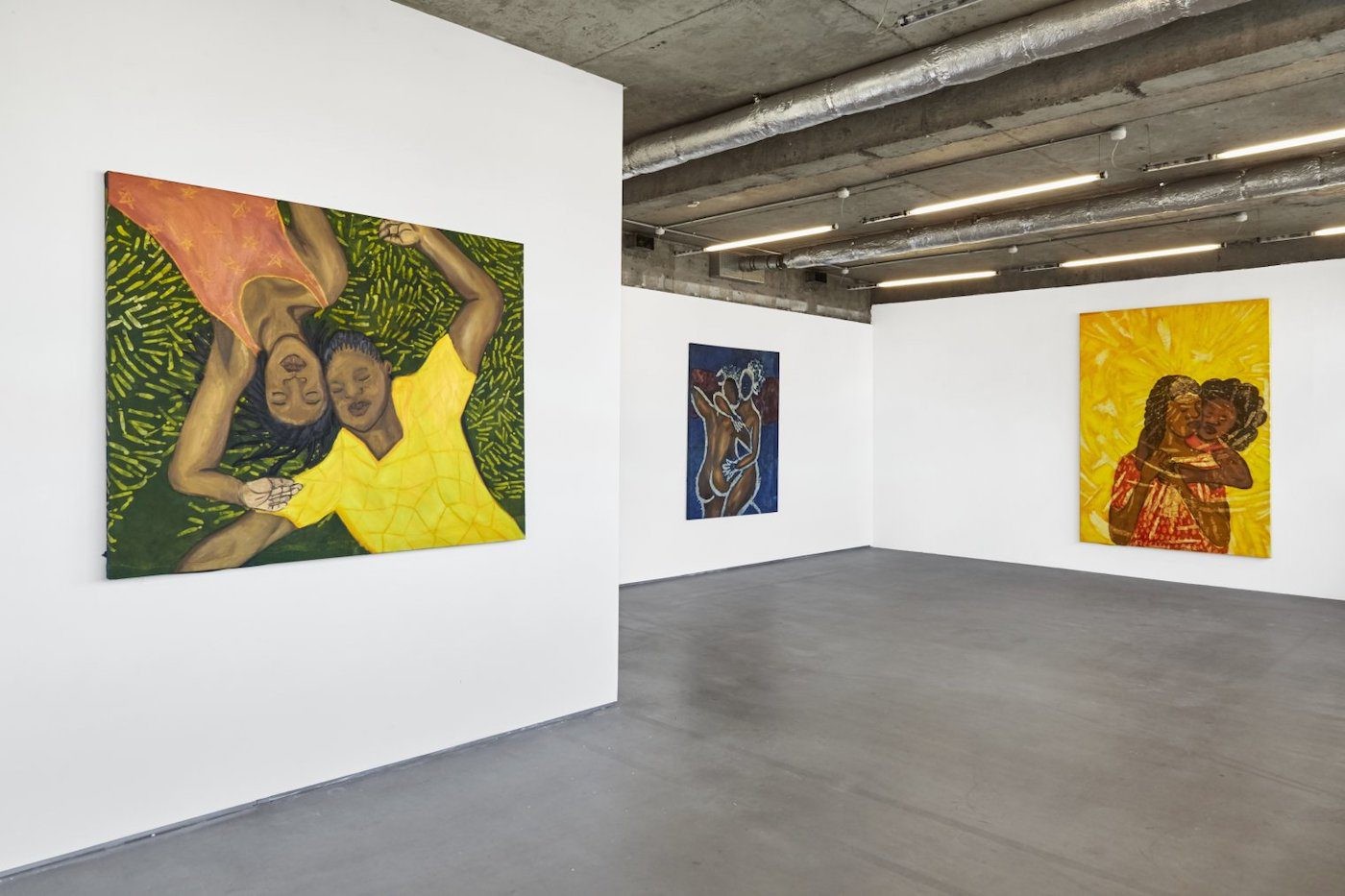
Sola Olulode, installation view, Laying in the grass , Entwined and Eternal Light, 2019.
In Safety (2019), two women lie in a wistful slumber under a wash of rich blue, a result of Olulode’s experiments with adire cloth, an indigo-dyed textile typically produced by Yoruba women in southwestern Nigeria. The inky, rich palette flattens the image. The bleached outlines of the figures and their features leap forward. Three horizontal strips of canvas – plum, lilac, and cerulean – form the bottom half of the work. Sewn together, the lateral strips of fabric form a quilt, covering the sleeping couple. The visible stitches prompt memories of sewing as a maternal act – so intimate and repetitive, homely and safe. “Would you say your practice functions as a consolidation of Yoruba textile traditions and the Western painting canon?” I ask. “Yes,” she replies. “I do want to represent that part of my … I don’t want to say ‘ancestry’ … it’s a part of myself.”
Where the Ocean Meets the Beach is a deeply soothing show. Sola Olulode’s untethered, transient figures – queer, Black, women, femme-identifying, and non-binary people – enjoy a love undisturbed. Her romantic fantasies remind us of the potential of paint on canvas, while the ambiguity of her politicized bodies engage with the social constructs that have prevented such artwork from having been made before.
Where the Ocean Meets the Beach takes place in London at V.O Curation. Due to the current health crisis the exhibition will remain temporarily closed. Please find further information on their website:vocurations.com
Olamiju Fajemisin is a British-Nigerian freelance writer based in Berlin. Her work focuses on art, music and contemporary culture with an emphasis on race.
Read more from
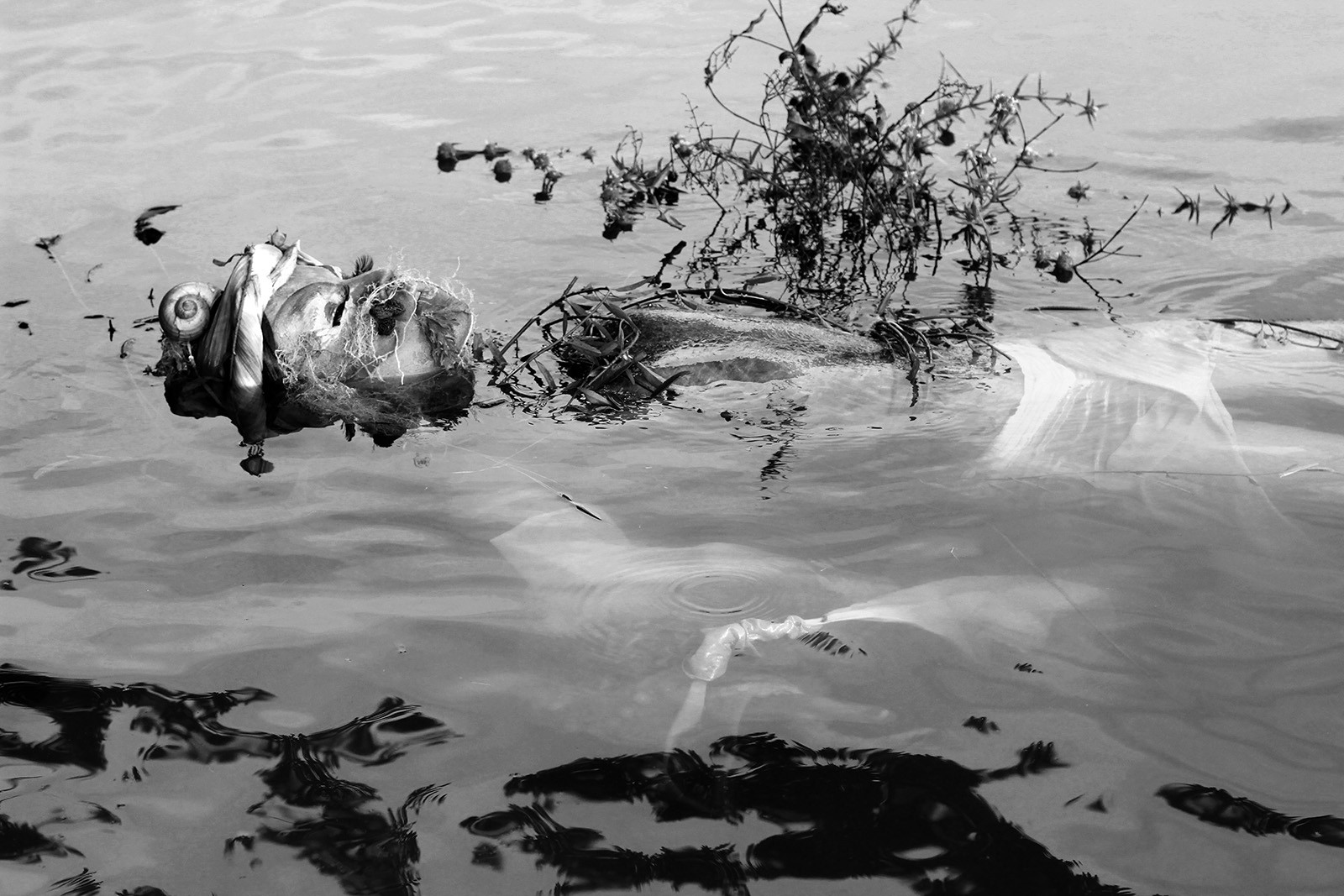
Flooded Memories
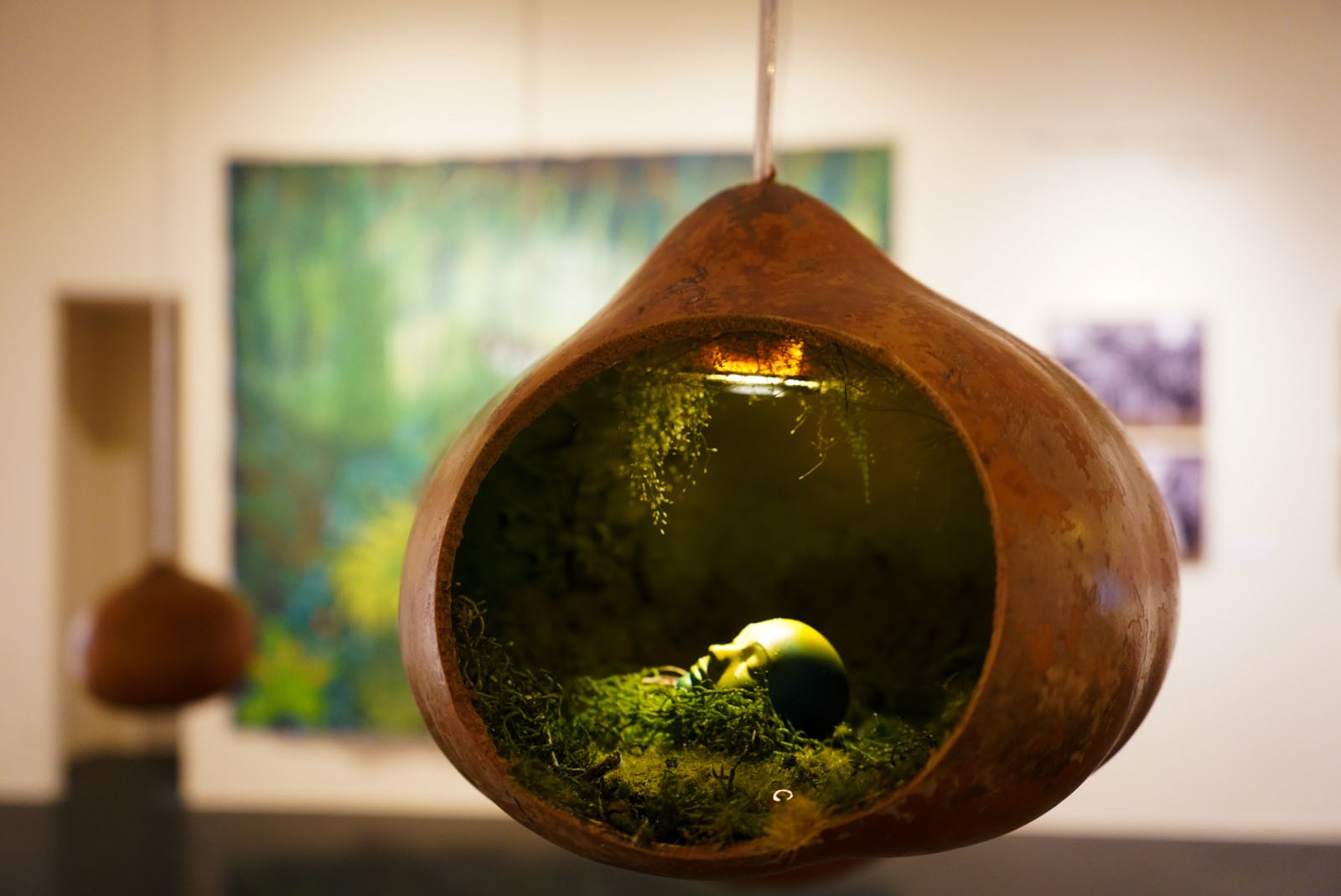
Roots: Beginning, Middle, and Beginning
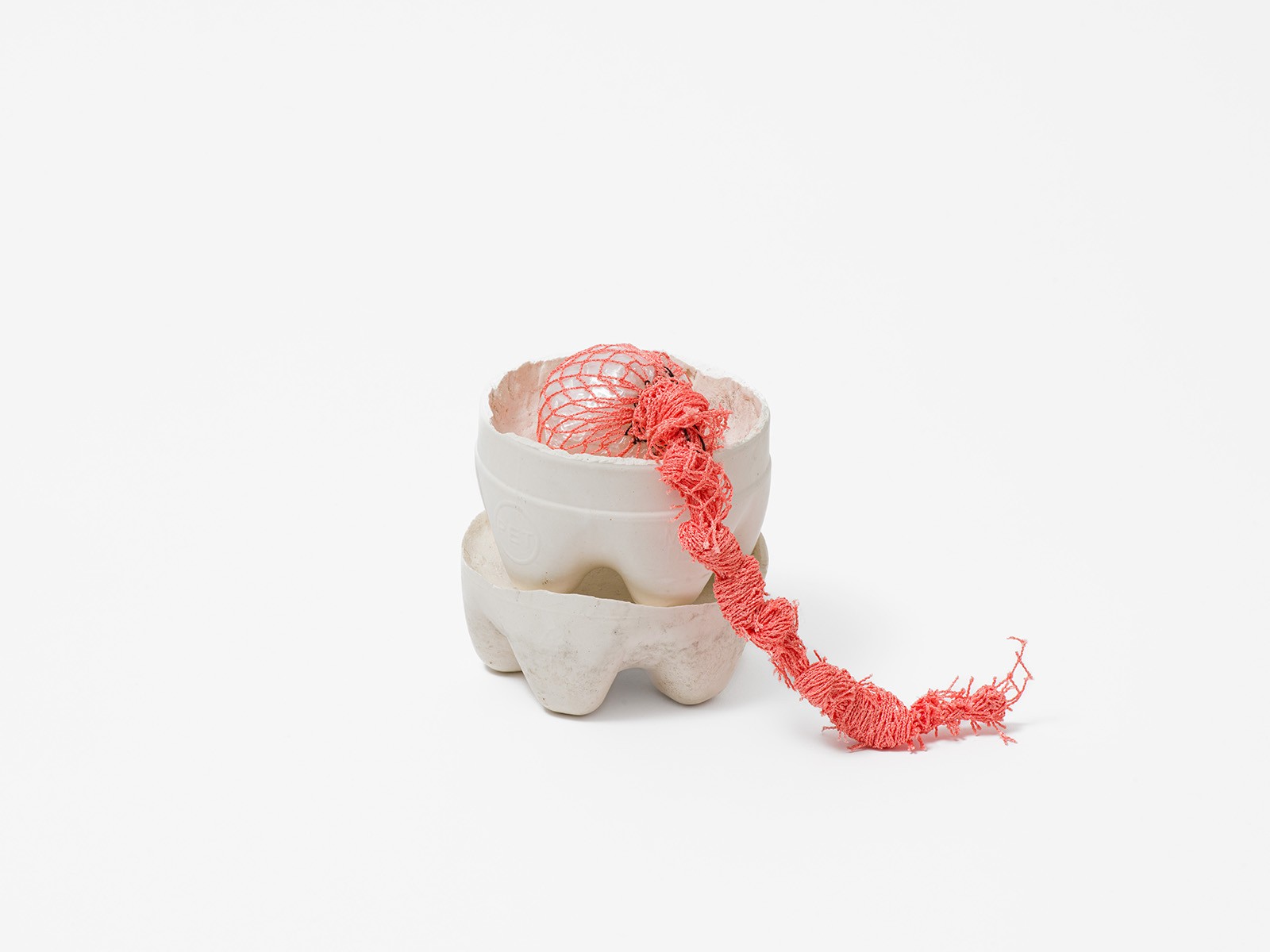
Veronica Ryan: Unruly Objects
Read more from
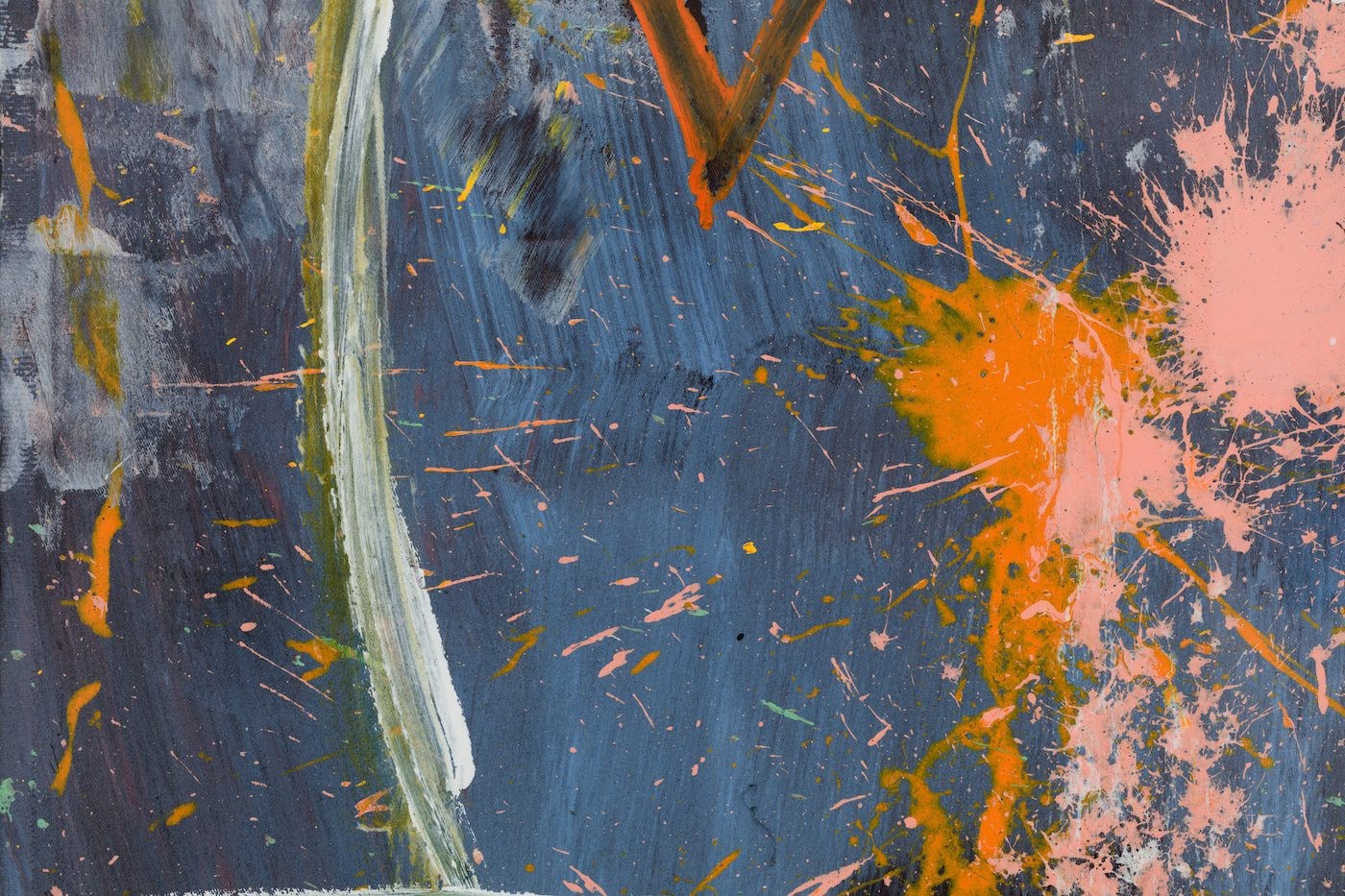
Samson Mnisi: A Master Posthumously Receives His Due

LGBTQIA+ Diversity Stories
